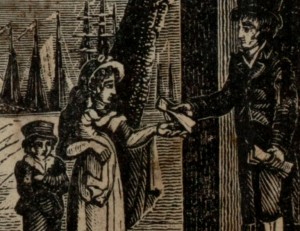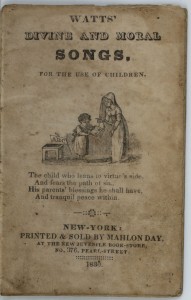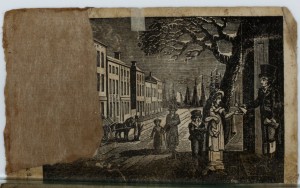 Recently, I was catching up on cataloging the nineteenth-century editions of Isaac Watts’ Divine Songs given to us by the great collector of early American and English children’s books Wilbur Macey Stone (1862-1941). One of them, a well-worn edition issued by New York publisher Mahlon Day in 1830, contains a mutilated frontispiece depicting this interesting and mysterious scene (which, as far as I can tell, has nothing to do with the text). According to researcher Jane Pomeroy, this book contains some wood engravings by master engraver Alexander Anderson, but this illustration is not among them. (Jane, if you are out there, correct me if I am wrong!)
Recently, I was catching up on cataloging the nineteenth-century editions of Isaac Watts’ Divine Songs given to us by the great collector of early American and English children’s books Wilbur Macey Stone (1862-1941). One of them, a well-worn edition issued by New York publisher Mahlon Day in 1830, contains a mutilated frontispiece depicting this interesting and mysterious scene (which, as far as I can tell, has nothing to do with the text). According to researcher Jane Pomeroy, this book contains some wood engravings by master engraver Alexander Anderson, but this illustration is not among them. (Jane, if you are out there, correct me if I am wrong!)  My colleague, Lauren Hewes (AAS’s curator of graphic arts), and I examined this image together and came up with the following observations.
My colleague, Lauren Hewes (AAS’s curator of graphic arts), and I examined this image together and came up with the following observations.

The frontispiece depicts an urban scene set in winter; note the snow on the leafless tree, and the row houses with chimneys belching smoke. The scene’s central figures are a woman carrying a baby (her young son follows closely behind) who is receiving what appears to be an envelope from a man at the front door of a building; it is unclear whether it is a business or private residence; conceivably, it is a merchant’s office on the first floor with his residence on the upper floor. Lauren and I agreed that the woman was no beggar; she wears a bonnet (as a respectable woman would have worn when going out in public; her son wears a hat as well), and her clothes (like those worn by her son) are neat, and neither dirty nor torn. However, they are in physical need; the mother and her baby are wearing clothes with short sleeves, despite the snow; and the little boy has his arms across his chest, as if shivering. Likewise, the man at the door is dressed formally in top hat and suit jacket; he looks like a businessman. Also, the woman is receiving an envelope; generally, images from the early nineteenth century depict beggars receiving loose coins. Could the item being handed over be an envelope containing her husband’s wages, which would more likely be in paper currency? Finally, the prominence of the tall ships in the background gave us reason to pause; not only was the scene urban, it was definitely a port. Perhaps this was a sailor’s widow receiving her deceased husband’s final wages. And what of the people in the man and child in the background? Are they are also in line to receive one of the other envelopes held by the man, or are they mere passersby? And what clues are missing from this mutilated image? In the background near the tear there is a horse-drawn vehicle being tended by a man in a top hat. Exactly what is the horse pulling? It could be a hearse, a coach, or a vegetable cart, among many things.
This image is so immediately compelling for all of its detail that tells so much, and yet leaves so much ambiguous. I want to put some decent subject headings in the catalog record that will help future researchers to find this image. If you have seen the full image, or have an idea of its story, I would love to hear from you.

Hi Laura: This website identifies Mahlon Day as a publisher of children’s books and New York street scenes. http://www.lib.rochester.edu/index.cfm?PAGE=3393
Perhaps the image was reprinted from one of the street scene books (looking from Pearl St. down toward South St.?) and meant to connect in readers’ minds the effects of urban poverty on children with a proposed solution–the moral uplift of the hymns. Just a thought.
Dear Brian,
I think your assumption is quite reasonable, given Mahlon Day’s ongoing commitment to publishing children’s books conveying a sense of social conscience. I was just wondering whether there was a definite story the image was attached to in a prior bibliographic life. Thanks so much for the hyperlink to the article on Mahlon Day.
Sincerely,
Laura Wasowicz
Perhaps consider the larger list of Mahlon Day imprints. Wasn’t he also the person who published the annual reports of the Society for the Reformation of Juvenile Delinquents (including the lists of inmates at the House of Refuge)?
Right you are, Seth! Mahlon Day was deeply involved in printing for social welfare organizations. I will be posting a sequel to this blog piece soon, revealing the full image and a telling caption to the image not found in the AAS imperfect copy.
The nineteenth-century editions of Isaac Watts’ Divine Songs was really amazing. Thank you so much for sharing this information. I’m glad I bumped into this interesting post.
My Last Post:
http://greatcustomcabinets.com